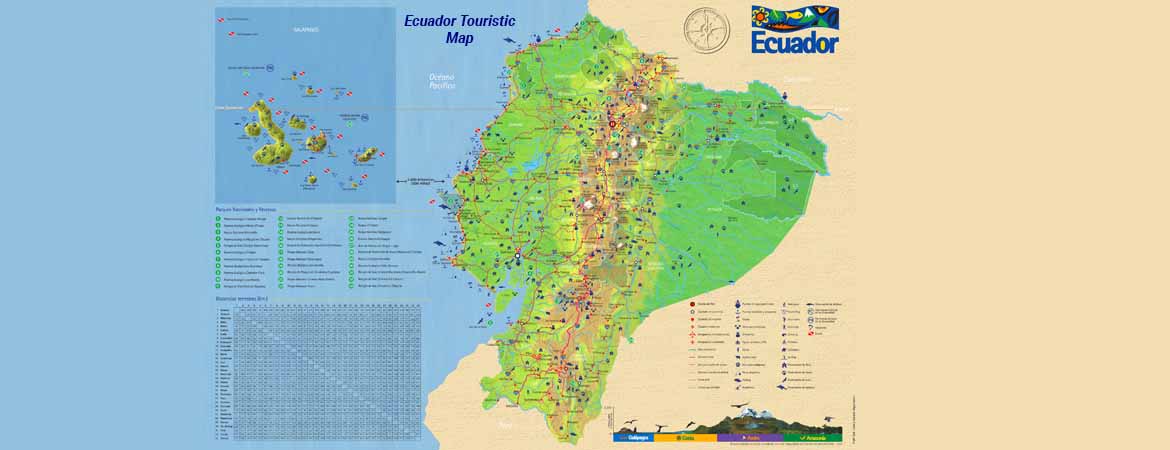About Ecuador

Background
 What is now Ecuador formed part of the northern Inca Empire until the Spanish conquest in 1533. Quito became a seat of Spanish colonial government in 1563 and part of the Viceroyalty of New Granada in 1717. The territories of the Viceroyalty - New Granada (Colombia), Venezuela, and Quito - gained their independence by 1819 and formed a federation known as Gran Colombia. When Quito withdrew in 1830, the traditional name was changed in favour of the "Republic of the Equator." Between 1904 and 1942, Ecuador lost territories in a series of conflicts with its neighbours. A border war with Peru that flared in 1995 was resolved in 1999. Although Ecuador marked 25 years of civilian governance in 2004, the period has been marred by political instability. Seven presidents have governed Ecuador since 1996.
What is now Ecuador formed part of the northern Inca Empire until the Spanish conquest in 1533. Quito became a seat of Spanish colonial government in 1563 and part of the Viceroyalty of New Granada in 1717. The territories of the Viceroyalty - New Granada (Colombia), Venezuela, and Quito - gained their independence by 1819 and formed a federation known as Gran Colombia. When Quito withdrew in 1830, the traditional name was changed in favour of the "Republic of the Equator." Between 1904 and 1942, Ecuador lost territories in a series of conflicts with its neighbours. A border war with Peru that flared in 1995 was resolved in 1999. Although Ecuador marked 25 years of civilian governance in 2004, the period has been marred by political instability. Seven presidents have governed Ecuador since 1996.
Size
Ecuador is located in the West side of South America, bordering the Pacific Ocean at the Equator, between Colombia and Peru and its extension is 283.560 sq. Km. being one of the smallest countries in South America about the same size of Nevada.
Population
13,547,510 (July 2006 est.)
Mestizo (mixed Amerindian and white) 65%, Amerindian 25%, Spanish and others 7%, black 3%.
Currency
Ecuador has adopted the US dollar as its official currency since 1999, although local coins circulate among the American ones.
Electricity
110 Volts, 60 cycles, AC.
Local time
G.M.T. - 5 hours mainland Ecuador
G.M.T. - 6 hours Galapagos Islands
Languages
Spanish (official), Amerindian languages (especially Quechua)
Climate
Ecuador is located in a Tropical Zone. The climate throughout the country ranges from tropical Equatorial rainy weather to perpetual snow on the top of the mountains due to the influence of the Andean Mountain range in the highlands. Cities in the highlands have temperatures that vary from 50 to 70 degrees Fahrenheit, while coastal cities temperatures vary from 60 to 80 degrees Fahrenheit during the day. The jungle has constant weather conditions: rainy, humid and warm. The Galapagos Islands are always sunny and warm. Temperature drops a bit during the months of June to November.
What to wear
1) Quito and highlands: wear spring attire during June, July and August. During the rest of the months bring warmer clothing like those you would wear during the fall. A raincoat or jacket would be useful at night since it gets pretty cold.
2) Guayaquil and other coastal cities: wear summer clothing all year round. During the rainy months, December to May, the weather is still very warm. During the months of June to November the weather is cloudy and a bit colder.
3) Galapagos: wear comfortable walking shoes and casual clothing. Shorts, t-shirts and summer clothing will be just fine. Do not forget a hat and sun block, as they are a must along with a bathing suit.
4) Amazon or Jungle: wear clothing adequate for the rainy season. If you can get yourself a raincoat, take it with you, as well as several sets of light pants and long sleeves shirts. Shorts are less useful because of the insects and abundant vegetation you will walk through on your excursions. Rubber boots and insect repellents are necessary to take along with a hat. If you want to take pictures you will need a high speed film.
Tourist Visa
All visitors can stay in Ecuador up to 90 days without a tourist visa.


